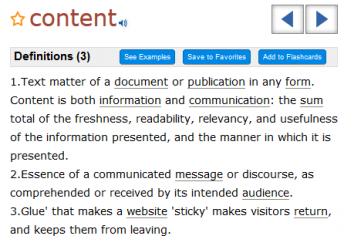What is content? Find it in dark corners!
22 February 2016 By Northern Lights

I recently ran the social media management training day for the CIPR. We had a great group and for one of the exercises, I got everyone thinking about what content they have already in their organisation that they can reformat – or repurpose as the jargon goes.
Someone then asked me to define ‘content’. I had been explaining that things like blogs, videos, photos, white papers, guides and so on should be at the heart of your social media activities and these are your content.
But then to define, what is ‘content’ – I found it hard to be precise!
So over lunch I searched this very question, what is ‘content’ and found dozens of definitions. The Business Dictionary defines it as information and communication – and refers to it as the ‘glue’ that makes a website sticky; this means people want to keep coming back to that website or page for useful information.
The best definition and explanations came from Lee Odden’s Top Rank blog on, surprisingly!, What is content? Learn from 40+ definitions.
Lee put this question out on his social media networks and used the replies to shape his blog (a great way of researching and refining ideas).
From the replies he put together a few themes on what content is but also said “Content is many things to different people and situations due to context. Fundamentally, content = information. Content = experience. Content = nothing specific.”
His themes were
- Content is Information (practical, functional, tactical)
- Content is Experience (Useful, Purposeful, Outcome Oriented)
- “Content” is Too Ambiguous to Define
I thought in this blog I would share why content is so important – and what the CIPR group came up with as ideas for content. Hopefully this will give you some ideas for your own social media.
Why is content important?
If it is important for your business to come top of Google searches, then content is king. I have written about this before in our blog on how to think like a search engine – this is also a critical part of your content being found.
Google wants to give searchers the best quality information at the top of any search. Its algorithms look at websites and rank highest
- Good quality information created to help the reader, not to promote their business
- Updated regularly – if you haven’t updated anything on your website for a few months, this is unlikely to get highly ranked
- Shared on social media – this gives Google an indication that others are rating and sharing this information
So what does this ‘content’ look like? This is where a really good quality blog is at the heart of many social media strategies. It can answer client or customer questions, be updated weekly (typically) and easily be shared.
But other forms of content include videos, photos, online guides, white paper, research and more.
Find content in dark corners
I came up with this phrase which seemed to go down well! Most organisations have huge amounts of content – but often focus on producing new material the whole time. When the CIPR training group had a think about what they have already, these were just a few of the ideas they mentioned
- Archive materials produced for anniversaries
- Customer photos that had been sent in or tweeted, in a campaign
- Health and safety guides (very specialised)
- Visitor information tips
- Research carried out to develop a new marketing campaign – it could be repackaged as public insights, holding back on anything that gave competitive advantage
- School information packs
- Proposals for clients – some of the insights about client problems could be anonymised and used as the basis for blogs
- Unused photos and video clips from a marketing campaign – interviews and customer comments
The trick with all these is not to use them at random. You still need to create your social media strategy – linked to the business and marketing plans – and then see how this content can help deliver your key objectives and engage with target audiences. It will almost certainly need repurposing – shaping into different formats – and used over a period of time. A weighty tome written on corporate law could probably be broken down into a dozen simple download guides and/or 20 or more blogs.
What is the best bit of content that you found in a dark corner, and how did you repurpose it?! We’d love to hear your stories and happy to share them in our next training session (and give you a bit of PR in the process!).


